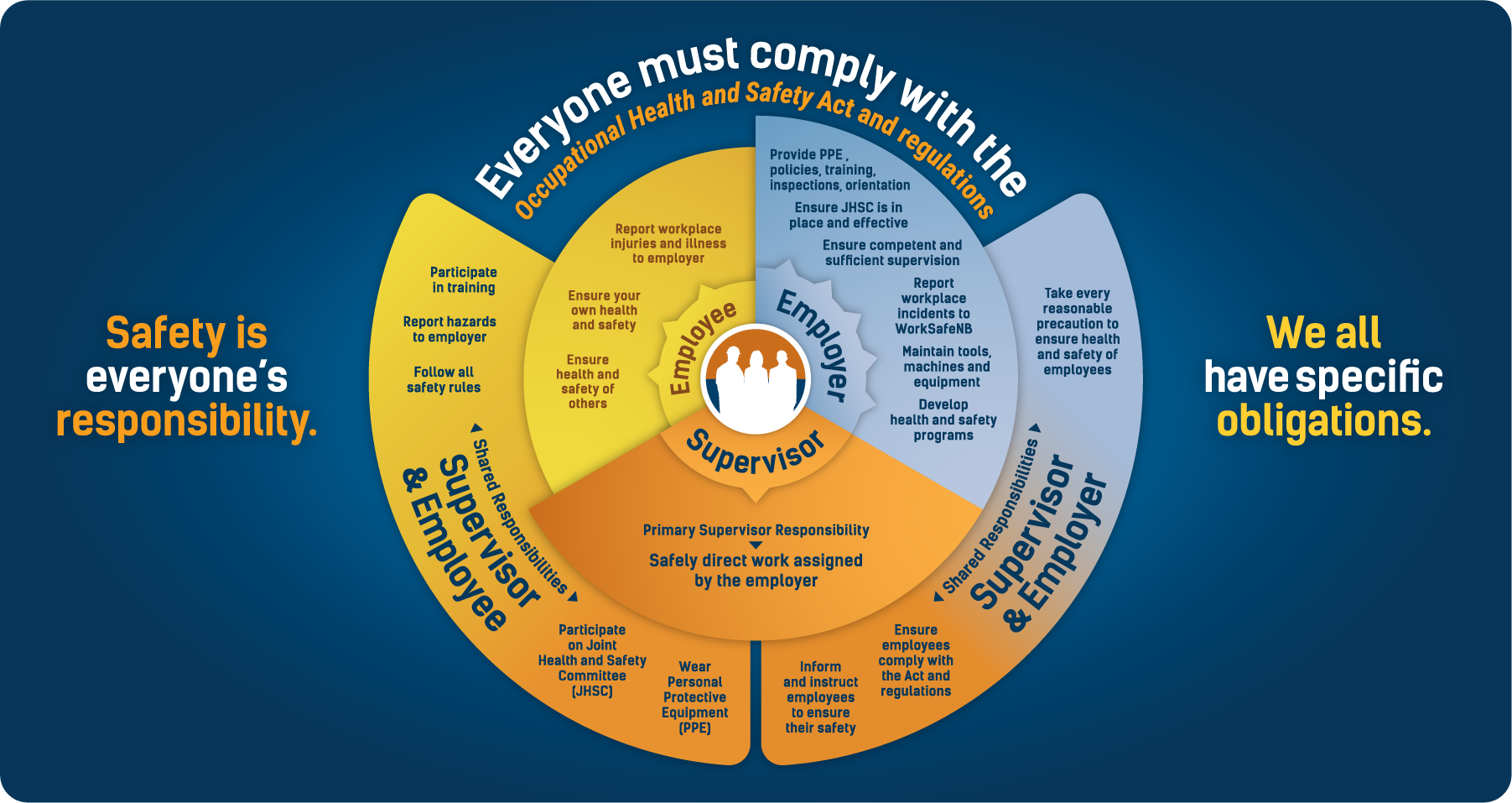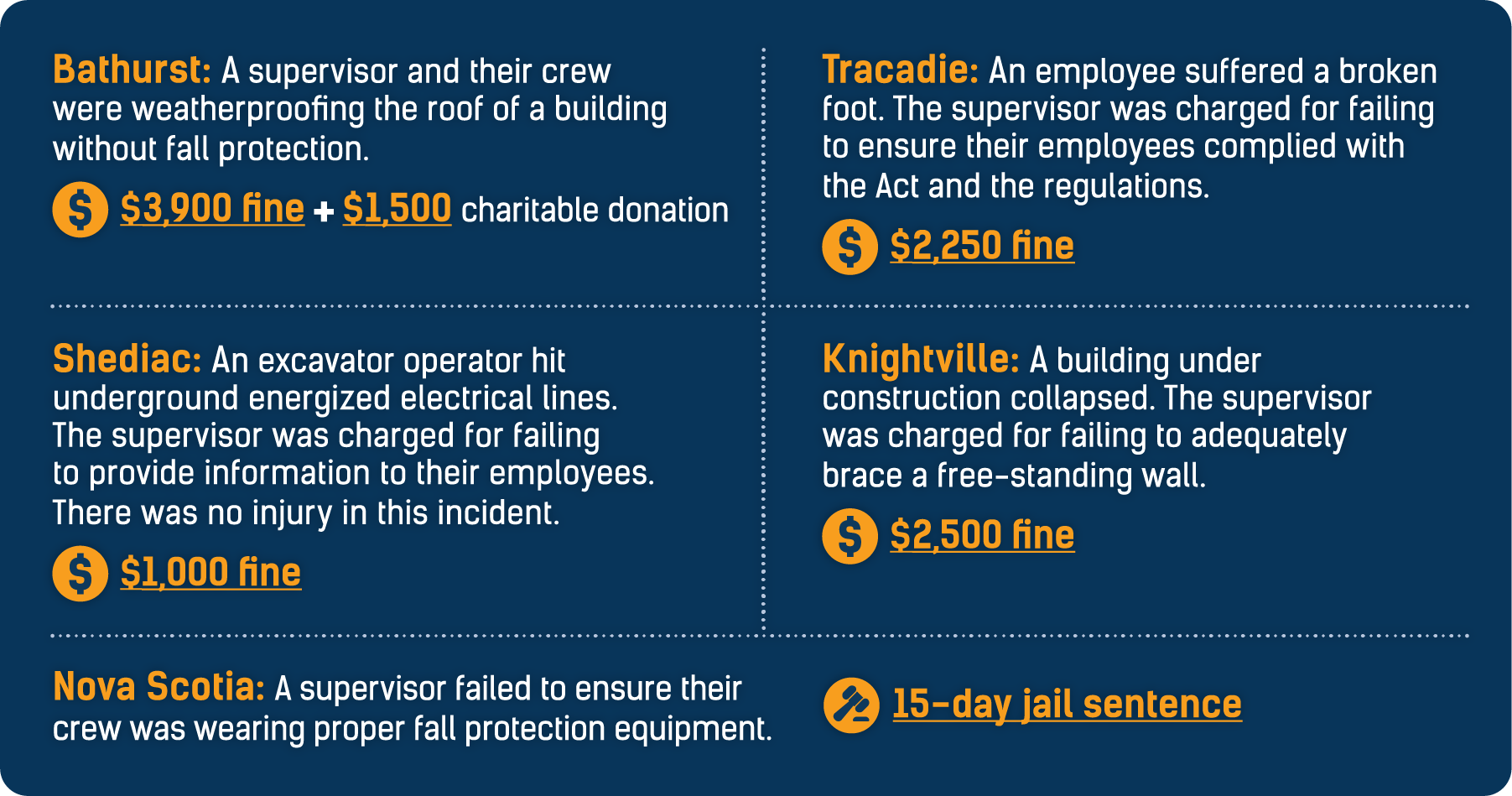


The Occupational Health and Safety Act recently clarified the responsibilities of supervisors.
We know you want to keep your teams safe. If you want help understanding what constitutes competent and sufficient supervision, or if you’re not sure how these obligations fit within your workplace, give us a call 1 800 999-9775.
This wheel demonstrates the unique and shared responsibilities of supervisors, employees and employers. A full list of your obligations with helpful resources follows.
 A supervisor is a person authorized by an employer to supervise or direct the work of employees. This includes people from first-level supervision on the shop floor, to the manager, to the CEO. A supervisor's responsibilities include:
A supervisor is a person authorized by an employer to supervise or direct the work of employees. This includes people from first-level supervision on the shop floor, to the manager, to the CEO. A supervisor's responsibilities include:
We want to profile New Brunswick supervisors committed to engaging their teams in health and safety. Know one? Send us a message!
 An individual or company can be prosecuted if they don't follow the requirements of the OHS Act and the regulations. Here are examples of supervisors who were recently prosecuted:
An individual or company can be prosecuted if they don't follow the requirements of the OHS Act and the regulations. Here are examples of supervisors who were recently prosecuted:

 An employer employs one or more employees. An employer's responsibilities include:
An employer employs one or more employees. An employer's responsibilities include:

An employee is a person employed at a workplace. An employee's responsibilities include:
New! For employers - Supervisor Assessment Tool
Download the Action Plan Template here.
There are no new responsibilities created by the change to legislation for supervisor. The goal is to clarify the employer’s and supervisor’s roles and responsibilities and to help identify who is considered a supervisor. The changes actually removed some responsibilities that supervisors had before the change to legislation and made them solely a responsibility of the employer (company). For example, training is no longer a supervisor’s responsibility; although the employer may delegate that task to a supervisor, training remains the employer’s responsibility. More information on supervision is found in the OHS guide.
No, WorkSafeNB does not determine who can be a supervisor but the legislation can help clarify if, based on particular task(s) or responsibilities, someone is considered a supervisor under the OHS Act. WorkSafeNB can highlight where there may be gaps, such as necessary knowledge, adequate training and compliance to the legislation. In addition, WorkSafeNB can use its compliance power if it identifies that supervision is not adequate at a workplace.
No. However, as the supervisor, you will be required to have sufficient knowledge in regard to your employer’s safety policy, program and procedures and the required protective equipment for the work (including electrical work) under your supervision. In addition, as the supervisor, you will need to be familiar with the hazards and the legislative sections that apply to the work you supervise.
If an employee directs the work of other employees, WorkSafeNB considers them to be a supervisor. It is the employer’s responsibility to provide the supervisor with sufficient knowledge and to support them in meeting their supervisory responsibilities, such as:
If a supervisor directs the work of employees, they normally would assume all the supervisory responsibilities outlined in the Occupational Health and Safety Act. To ensure the supervisor understands this, you must communicate the expectations and regularly assess their competency, sufficiency and behaviour. The responsibility for safety should be included in the supervisor’s job description to ensure they understand and accept this important responsibility. Periodically reviewing the supervisor’s performance to determine if there are gaps is another important step to ensure supervision is competent and sufficient at your workplace.
The Act is silent on that matter. However, the more guidance and instruction that must be provided to employees, the smaller the team must be to ensure that sufficient supervision is provided.
There will naturally be circumstances when a supervisor will not be on site. We do not expect supervisors to spend 100% of their time with their employees. The following factors will help determine how much supervision is actually needed:
In the context of supervision, “sufficient” means having enough oversight on the work being carried out to ensure the health and safety of persons involved in the work. To determine the sufficiency of supervision provided at your workplace, the officer will compare the level of supervision against these four factors:
If the level of supervision provided at the workplace is found to be lower than the level required as determined by the officer’s assessment, then the officer may issue an order to the employer to remedy the situation.
Employers must ensure that supervisors are competent through training and/or experience for the work they supervise. This means having the necessary knowledge of the work being carried out, including the potential work hazards, preventive measures for those hazards and the legislation pertaining to that work. Because competency is dependant on the work being supervised, there is no one course that supervisors can take to meet the competency requirements. They can acquire some knowledge by completing courses provided online by WorkSafeNB, through external training providers or in-house. Some of the knowledge the supervisors need to safely direct the work is workplace specific, including knowledge of work processes, policies, procedures, programs and required PPE.
A supervisor can be either. The OHS Act requires that a committee consist of equal representation from both the employer and the employees, and that the employer designate their representative or representatives and the employees do the same. In most cases, an employer designates a supervisor to represent the employer. However, if a supervisor is designated by the employees to be their representative, the supervisor can represent the employees on the committee.
As an employee you should first discuss your concerns with your supervisor. While this can be a difficult conversation, particularly if the issue pertains to your supervisor, it is an important and necessary conversation. If discussions with your supervisor do not resolve the situation or you don’t feel comfortable bringing the issue(s) to your supervisor, you should bring your concern to the JHSC or the health and safety representative if you have one at your workplace. If you still have a concern regarding supervision after following these steps, or you don’t have a JHSC or H&S Rep, you can contact WorkSafeNB at 1 800 999-9775 for follow-up.
New! For employers - Supervisor Assessment Tool
Download the Action Plan Template here.
OHS Act - Responsibility Wheel poster
Download to print or email (another option)
Supervisor – Legal implications poster
Who is a supervisor poster
Interpretation
Other
Start with safety – your responsibilities
Supervisor Obligations (video)